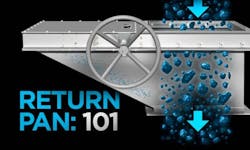Return Pan: 101
Slide gates are a main component of many dry material handling systems: They are designed to be open (establishing material flow), closed (stopping material flow), or partially open (to limit material flow). Most slide gates are designed with some type of sealing mechanism to contain the material being handled within the system. Without proper sealing, material can escape to the atmosphere and become product waste, reducing profitability or creating potential health issues.
In certain instances, the sealing of material becomes difficult. These situations may include the overall size of the gate, the abrasiveness of the material handled, size of the material handled, and location of the gate making it difficult to access and maintain. In these instances, equipping the slide gate with a return pan would be beneficial.
Vortex Return Pan
A return pan is a fabricated metal piece designed to fit on the outlet (bottom) side of the gate. It is an angled ramp that extends from the back of the gate to the outlet opening. The ramp gets deeper as it approaches the outlet. Material escaping the sealing is deposited on the ramp portion of the return pan instead of escaping to the atmosphere. As build-up occurs, the material eventually slides down the ramp and into the flow stream or outlet discharge. Material is retained within the system.
Without a return pan, material can potentially make its way past worn seals and either escape to the atmosphere or fill up the bonnet area where the blade is parked when it is in the open position to create blade actuation problems.
Return pans should be used when the gate is installed in a horizontal orientation with material flowing vertically through the gate. The slope of the pan should come close to matching the angle of repose of the material handled
One thing to remember when considering a return pan is it will increase the flange-to-flange mounting dimension needed for installation. A good gate manufacturer can help verify that your gate and return pan will fit in your material handling system.
Return pans are more likely to be specified for use with mineral and aggregate applications. They are an inexpensive way to contain stray material, to protect workers, and to safeguard the environment.
The sloping pan returns fine materials that escape through the bonnet back into the material flow stream


